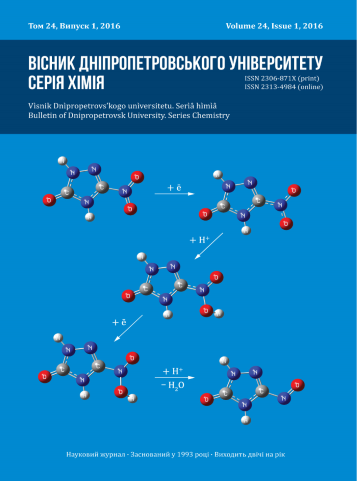Colloid-chemical properties of suspension electrolytes for obtaining of PbO<sub>2</sub>–TiO<sub>2</sub> composite materials
DOI:
https://doi.org/10.15421/081604Keywords:
electrolyte, size of particles, titan dioxide, aggregative stabilityAbstract
The sizes of colloid particles and aggregate stability of nitrate and methanesulfonate suspension electrolytes used for obtaining of PbO2–TiO2composite materials were investigated. It is found, that TiO2colloid solutions at the presence of the big surpluses of plumbum ions and acids are inclined to fast aggregation. The same effect results also introduction in electrolytes of the sodium dodecylsulfate additives. It was established that the adsorption of sodium dodecylsulfate on the TiO2 powder had a weak specific nature, as evidenced by the low value of the energy of adsorption interaction. As a result of the conducted researches it was established that aggregately stable suspension electrolytes may be derived from sols of titanium dioxide, which are formed by the hydrolysis of titanium isopropylate. Optimum conditions of obtaining of electrolytes with high aggregative stability were determined: рН ~ 1, concentration Pb(II) salt – 0.1 M, the size of particles TiO2 sol – no more than 14 nm.a
References
Velichenko, A. B., Knysh, V. A., Luk’yanenko, T. V., Devilly, D., & Danilov, F. I. (2008). PbO2–TiO2 Composites: Electrosynthesis and Physicochemical Properties. Russ. J. of Applied Chemistry, 81(6), 994–999.
Velichenko, A. B., Knysh, V. A., Luk’yanenko, T. V., Danilov, F. I., & Devilliers, D. (2009). PbO2–TiO2 Composite Electrodes. Prot. of Metals and Physical Chemistry of Surfaces, 45(3), 327–332.
Velichenko, A. B., Knysh, V. A., Luk'yanenko, T. V., Velichenko, Yu. A., & Devilliers, D. (2012). Electrodeposition PbO2–TiO2 and PbO2–ZrO2 and its physicochemical properties. Materials Chemistry and Physics, 131(3), 686–693.
Barbe’, C. J., Arendse’, F., Comte, P., Jirousek, M., Lenzmann, F., Shklover, V., & Graetzel, M. (1997). Nanocrystalline Titanium Oxide Electrodes for Photovoltaic Applications J. Amer. Geram. Soc., 80, 3157-3171.
Gribov, L. A. (1976). [Introduction to molecular spectroscopy]. Moskow, USSR: Nauka (in Russian).
Velichenko, A. B., Kasyan, O. I., Knish, V. A., & Lukyanenko, T. V. (2015). [Composite electrocatalysts containing valve metals oxides: preparation, physico-chemical properties and electrocatalytic activity]. Voprosy khimii i khimicheskoi technologii – Issues of Chemistry and Chemical Technology, (2), 7–24 (in Ukrainian).
Tsevis, A., Spanos, N., Koutsoukos, P. G., Linde, A. J., & Lyklema, J. (1998). Preparation and characterization of anatase powders. J. Chem. Soc., Faraday Trans, 94(2), 295–300.
Nikolsky, B. P. (1965). [Reference Book in Chemistry. Vol. 2: Basic Properties of Inorganic and Organic Compounds]. Leningrad, USSR: Chemistry (in Russian).
Golovnin, V. A., Kaplunov, I. A., Malyshkina, O. V., Ped'ko, B. B., & Movchikova, A. A. (2013). Physical Principles. In Investigation Methods and Practical Application of Piezomaterials (272 p.). Moscow, USSR: Tekhnosfera Publishing House.
Parfit, G. (1986). [Adsorption from solutions on surfaces of solids] Moscow, USSR: Mir (in Russian).
Nechaev, E. A. (1989). [Chemisorption of organic compounds on oxides and metals]. Kharkov, USSR: Vischa shkola (in Ukrainian).
Downloads
Published
Issue
Section
License
Copyright (c) 2016 Oles Honchar Dnipropetrovsk National University

This work is licensed under a Creative Commons Attribution 4.0 International License.
- Authors reserve the right of attribution for the submitted manuscript, while transferring to the Journal the right to publish the article under the Creative Commons Attribution License. This license allows free distribution of the published work under the condition of proper attribution of the original authors and the initial publication source (i.e. the Journal)
- Authors have the right to enter into separate agreements for additional non-exclusive distribution of the work in the form it was published in the Journal (such as publishing the article on the institutional website or as a part of a monograph), provided the original publication in this Journal is properly referenced
- The Journal allows and encourages online publication of the manuscripts (such as on personal web pages), even when such a manuscript is still under editorial consideration, since it allows for a productive scientific discussion and better citation dynamics (see The Effect of Open Access).


